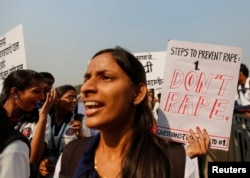One of Mumbai's best known colleges has banned female students from wearing ripped jeans, sparking the latest row against dress codes and curfews imposed on women that students say are discriminatory and sexist.
St. Xavier's College, which had previously forbidden female students from wearing shorts, sleeveless tops and short dresses, this month added ripped jeans to its list of banned clothing.
The Jesuit institution became the latest to incur the wrath of female students across the country who have been protesting rules that they say are discriminatory and distressing.
Most universities in India have a 6 p.m. or 8 p.m. curfew for women, while men have a later deadline, or no curfew. Universities also impose dress codes on women, limit or screen their male visitors, and have other rules that men don't.
"In the name of safety, you can't police women and impose these patriarchal, discriminatory rules," said Devangana Kalita, a former Delhi University student who is part of Pinjra Tod, or break the cage, a Delhi-wide campaign protesting such rules.
"We want universities to recognize that we are adults, and that they should not be curbing our freedom and mobility. Providing a safe environment for women goes beyond just imposing rules," she said.
Calls to staff at St. Xavier's College for a comment on the recent ban were not returned.
The Dean of Student Welfare in Delhi University, J.M. Khurana, said he was not aware of Pinjra Tod and that he did not wish to comment on university rules.
Violence sparked rules
The safety of women in India came under the spotlight after the fatal gang rape of a college student in New Delhi on a bus in December 2012 that sparked global outrage and led to the tightening of laws for crimes against women in India.
Amid a widening debate on women's safety in the country, some politicians, university officials and even the police have asked women to take self-defense training, to "dress decently" and to not loiter outside after dark.
But students have demanded an end to curfews, and asked officials to focus instead on safer public transport, more female campus security personnel, and better lighting in and around campuses.
Kalita said early curfews are keeping women from internships, employment opportunities and campus activities.
"Universities say: 'Your parents want the curfew.' But it's an absurd argument," Kalita said.
Demand for change growing
Elsewhere, particularly in the more conservative southern states, the situation is worse, said Vandana Venkatesh, who surveyed colleges in Tamil Nadu state earlier this year.
Female students reported physical intimidation and threats of violence from college authorities for questioning discriminatory rules, she said.
"Many of them complained about feeling claustrophobic, anxious and belittled," she said.
Earlier this month, female students in a college in the southern state of Kerala protested the hostel's 4 p.m. curfew and a rule banning mobile phones.
"There is a sense of collective strength and power now. The more women there are out on the streets, in public places, the safer we will be," Kalita said.










